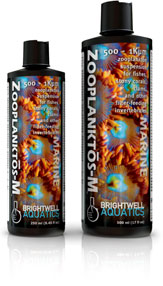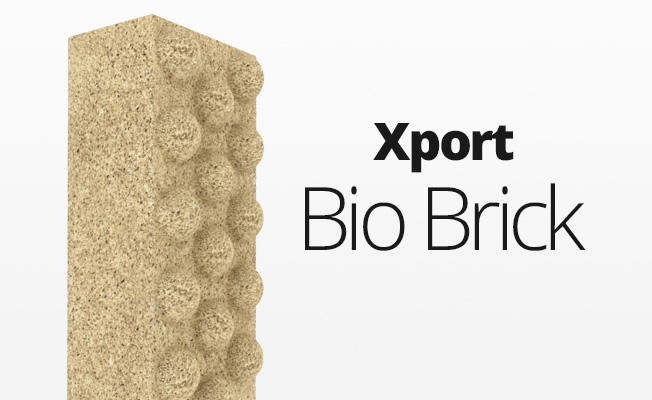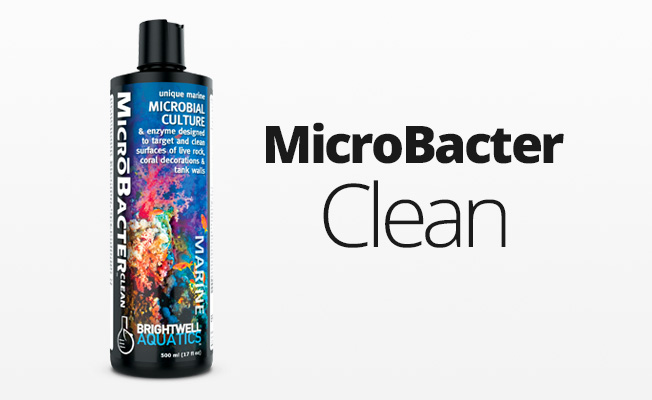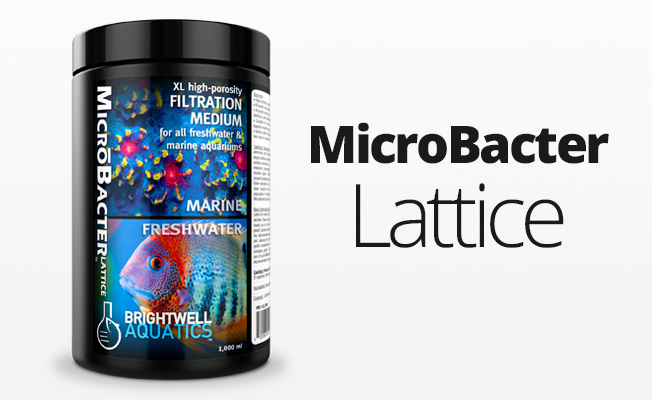500 - 1Kµm Zooplankton Suspension for Fishes, Stony Corals, Clams, and Other Filter-Feeders

Overview
- Provides zooplankton ranging in size from 500 - 1,000µm (1mm).
- Ideally-sized for many stony corals, clams, tube worms, larval crustaceans, juvenile fishes, and adult planktivorous and microinvertebrate-predatory fishes.
- Does not require refrigeration.
- Supplemented with a proprietary amino acid to aid incoloration of invertebrates and fishes.
- Formulated by a marine scientist.
Sizes
125ml | 250ml | 500ml | 2L | 20L
Technical Background
Brightwell Aquatics Zooplanktōs-M is a concentrated suspension of copepods, a group of zooplankton heavily preyed upon by various aquatic organisms because of their size. The specific variety of copepods present in Zooplanktōs-M are extremely rich in amino acids, omega-3 fatty acids, vitamins, and numerous carotenoid pigments, making them of exceptional nutritional value to the organisms that they are consumed by. These copepods fall within the mesoplankton (200.0 - 2,000.0µm) class of plankton. They are the proper size for feeding many species of stony corals (large- and small-polyp), as well as clams and other bivalves, plumed worms (Christmas tree worms, feather dusters, etc.), larval crustaceans and bivalves, juvenile fishes, and the adults of planktivorous fishes (such as anthias, basslets, pseudochromids, dartfishes, chromis, etc.) and microinvertebrate-predators (such as mandarinfishes, some gobies, dwarf wrasses, etc.).
Though Zooplanktōs-M provides a number of amino acids, one that is not naturally present has been added; this proprietary amino acid has been shown in studies to increase coloration of corals and other marine invertebrates. Additionally, a small percentage of vitamin-C is present to increase the benefits of Zooplanktōs-M, particularly to corals and their allies that have recently undergone fragmenting or propagation.
Zooplanktōs-M may be used in conjunction with other planktonic suspensions to provide a complete range of sizes to filter-feeding and planktivorous organisms.
Zooplanktōs-M does not require refrigeration, however storage in a cool, shaded area will prolong the activity of the vitamins. Refrigeration will maximize the shelf-life of the product.
Instructions and Guidelines
Shake product well before using. Turn protein skimmer and other forms of mechanical filtration off prior to adding food suspensions to aquaria, and allow 10 - 15 minutes after feeding before resuming operation of filtration.
Target Feeding (recommended): Target feeding may be carried out with a lengthy piece of rigid air tubing, plastic syringe, pipette, dropper, or similar device; pour 5 ml (1 capful) into a small container and suck a portion of this into the feeding device, then slowly discharge the contents of the device 2 - 4” upstream of the target organism(s). Repeat these steps as deemed necessary. Rinse the portion (inside and outside) of the feeder that was placed into aquarium water before placing it into this bottle (if feeding directly from the bottle rather than from a separate container); failure to do so will contaminate the product and encourage it to decompose.
Broadcast Feeding: Add up to 5 ml per 50 gallons of water in the entire aquarium system in an area of rapid water movement daily for the first four weeks of use; thereafter, the dosage may be increased as desired.
Notes: Add no more than 5 ml total of liquid food suspensions per 50 gallons of water in the entire aquarium system daily for the first four weeks of use; thereafter, the dosage may be gradually increased as desired. Starting out at a low dosage and gradually increasing it with time will allow the biological filtration in the aquarium to adjust to the increase in nutrients and prevent water quality from deteriorating.
Planktonic food suspensions (such as this one) are best utilized by target feeding specific invertebrates in an aquarium; in doing so, the majority of the food may be consumed by the intended organisms rather than ending up in filtration media or indirectly impacting water quality (as often occurs when indescriminately “broadcast feeding” by adding liquid food suspensions to a stream of water and allowing the contents to disperse randomly throughout the aquarium system).
Boosting the nutritional profile of any food: It is always a good idea to add vitamins, minerals and amino acids to any foods your are feeding. You can also add garlic or other healthy nutritional ingredients. Brightwell makes the following foods that are great additives, as well as are able to be added directly to the aquarium. CoralAminō, Restōr, AminŌmega,, Vitamarin-M, Vītamarin-C, Garlic Power, MaxAmino, & Angelixer.
Food Rotation: Foods for corals should be rotated to provide variety and a more complete nutritional profile. Brightwell recommends that you don't just mix all your foods together and feed the same thing every day. Feeding a broad range of nutrients will more closely simulate what animals encounter in their natural habitat. Do some research on your animals to see what their nutrional needs are. Brightwell makes a number of different planktonic and particulate foods that can be rotated to provide a more balanced diet. These can be fed in addition to the CoralAminō and Restōr which can be fed every day along with those foods. Some of them are: PhytōChrōm, PhytōGold, PhytōGreen, Zooplanktōs, Reef Blizzard A, L, O, and S, UltraPlanktōs, Macrōvore , Micrōvore, and Reef Snow.
Caution: Keep out of reach of children. Not for human consumption.
Guaranteed Analysis
Moisture (max) 99.30%, crude protein (min) 0.34%, crude fat (min) 0.35%, crude fiber (min) 0.12%.
Ingredients
Purified water, copepods of the order Cyclopoida (zooplankton), proprietary amino acids, Ascorbic acid, Citric acid


